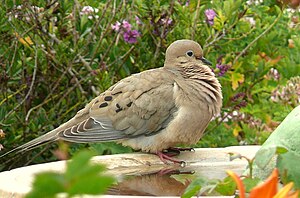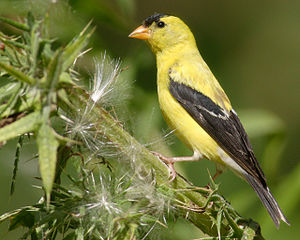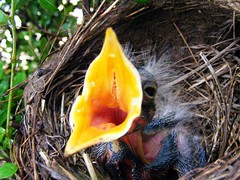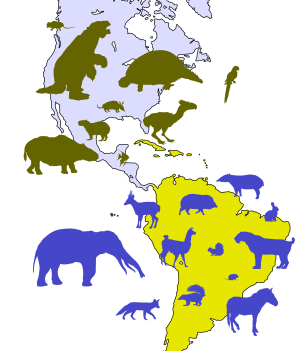Monday 12 July & Thursday 15 JulyMondayOur first of the season HY Common Yellowthroats and Cedar Waxwings showed up on Monday. This juvenile yellowthroat had dark feathering on top of its head and a deep yellow throat. I had to sex it as an unknown, but I find males seem to develop bright yellow throats and females tend to be more subdued. The bird banding lab will only allow us to sex young yellowthroats as male with black feathers emerging in the face.
Juvenile Cedar Waxwings display streaking on the breast that will disappear during the first prebasic molt (preformative molt). I was unable to determine male or female at this time on any of the three waxwings I banded today, although I suspect males due to the width of tipping to the tail feathers.
They all had orange tips to their tails. This indicates they've been feasting on recently introduced honeysuckle bushes. Normally tail tips are bright yellow.
Woodpeckers have a complicated molt strategy but there are numerous clues banders can use to determine young Downy Woodpeckers before their first prebasic molt. One is the elongated outermost primary feather (p10) that extends far below the primary coverts, the small feathers sitting on top of the primaries (outer 10 wing feathers).
Another is the presence of black streaking on the breast.
Lastly, male downys have red feathering on top of the head which will move to the rear of the head after its preformative molt. Females don't have red feathers although occasionally a few red feathers could show up.
If you are a beginning birder, one way to tell a Downy Woodpeckers from its larger counterpart the Hairy Woodpecker is to try to get a peak at the outer tail feathers. They will have streaks in a Downy (top picture) and no streaks in the Hairy (bottom photo).
I captured another juvenile male cardinal. At some point while his feathers were growing in he experienced extreme nutritional deficiency to a point where he had breaks in the feather vanes on his tail, known as fault bars.
His weight was lower than normal, but he seemed feisty enough and flew off well on release. The only way he would let me get a picture was to let him bite down on my skin. Ouch! Those bills are made for pinching...
Speaking of large bills you would think this House Finch would be eager to bite but they are fairly docile in the hand.
Here is a young Prairie Warbler looking a bit scruffy as he begins his preformative molt and takes on adult body plumage.
The preformative molt of the Yellow Warbler begins before fledging and this was a particularly handsome young individual.
Thursday
This day began by opening two nets near the banding table and all was calm. Jessica and I then made our way out to the north side of the island and opened the bluff nets. Young Song Sparrows began hitting the nets before we finished opening them. We couldn't even make it to the other nets I had planned on opening because we needed to get back and process the birds in hand. One of the juvenile Song Sparrows had avian pox on its toes, an occasional occurence. I've noted avian pox on birds that I've recaptured a year later with no evidence of pox except scarring. I imagine those birds with compromised immune systems would succumb to the disease. It is not a disease that is transmitted to humans.

We recaptured an adult male Song Sparrow originally banded by me as an adult in 2007. His central tail feathers were in such bad condition only the shafts were left. In some birds, feather wear is an indication of age. Young birds have poorer quality feathers that can deteriorate sooner than adult feathers, so we can sometimes determine a birds age by feather quality. Not so with Song Sparrows. They spend so much time in the brush that their feathers get worn down more easily than a bird perched in trees.
He didn't look too bad overall though.
Another clue for banders identifying young birds is the presence of growth bars in the tail and wings. Growth bars develop as the feathers grow in and indicates the amount of daytime growth (dark bands) versus nighttime growth (light bands). They are visible in both the wing and tail of this juvenile Song Sparrow. You can see the bands visible about halfway down through the wing feathers.
They may be a bit more apparent to you in the tail.
I was so happy to band our first Northerm Mockingbird this year, an adult female with a brood patch. She had finished nesting by the condition of her abdomen. Adults have yellowish eyes while juveniles eyes are darker. I've been concerned about the state of mockingbirds in recent years. We used to have large numbers nesting on or near the island and they've all but disappeared. I only banded one last year and none in 2008.
She had a crossed bill, another abnormality we sometimes come across. The deformity wasn't too bad, I've seen worse, and she seemed in good health.
We captured our first HY Eastern Towhee today. They are adorable! This is a young male.
Tick infestation on birds was very high today. Almost half of the birds were carrying deer ticks and one poor Song Sparrow had 50 of them! I was glad to relieve it of its tick burden. I removed 119 ticks overall, almost half the amount I've pulled off all year.
All in all it was a busy two days. I wonder if this is an early indication of an exceptionally busy fall. We ended up with 30 total Song Sparrows. Twice as many as we've banded the whole month of July in past years. We often see these numbers with catbirds, but not Songs before. Many thanks to Jessica Rempel who helped me on Thursday.
Total birds: 94 Total species: 36
Total banded species: 17 Birds/100 net-hours: 120
Osprey
Greater YellowlegsWilletLaughing GullHerring GullGreat Black-backed GullCommon TernDowny Woodpecker- 2Yellow-shafted FlickerEastern Phoebe-1Tree SwallowBarn SwallowBlue JayAmerican CrowFish CrowBlack-capped Chickadee-9Red-breasted NuthatchWhite-breasted NuthatchCarolina Wren-1American Robin-7Gray Catbird-24Northern Mockingbird-1Cedar Waxwing-3European StarlingYellow Warbler-5Prairie Warbler-1Common Yellowthroat-Northern Cardinal-3Eastern Towhee-1Song Sparrow-30Red-winged BlackbirdCommon GrackleBaltimore Oriole-1House Finch-1American Goldfinch-1
 PHILADELPHIA—In 1824 John James Audubon (1785-1851), the eminent artist of American birds and animals, created a drawing of a running grouse for use in the design for a New Jersey bank note. Although the artist mentions the drawing and the resulting engraved paper money in two separate diary entries, no one has ever been able to locate or identify such an illustration.
PHILADELPHIA—In 1824 John James Audubon (1785-1851), the eminent artist of American birds and animals, created a drawing of a running grouse for use in the design for a New Jersey bank note. Although the artist mentions the drawing and the resulting engraved paper money in two separate diary entries, no one has ever been able to locate or identify such an illustration. 


















































